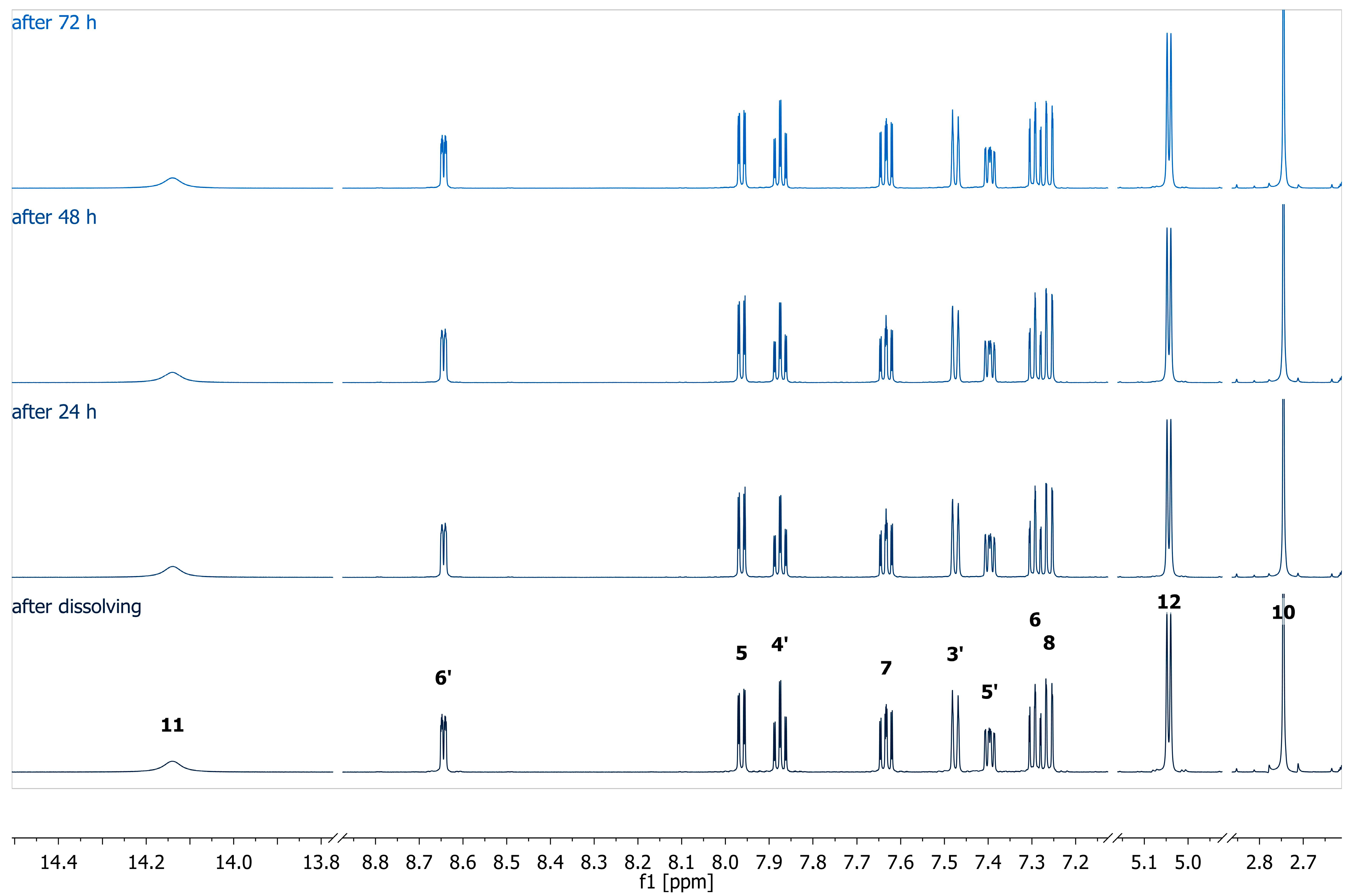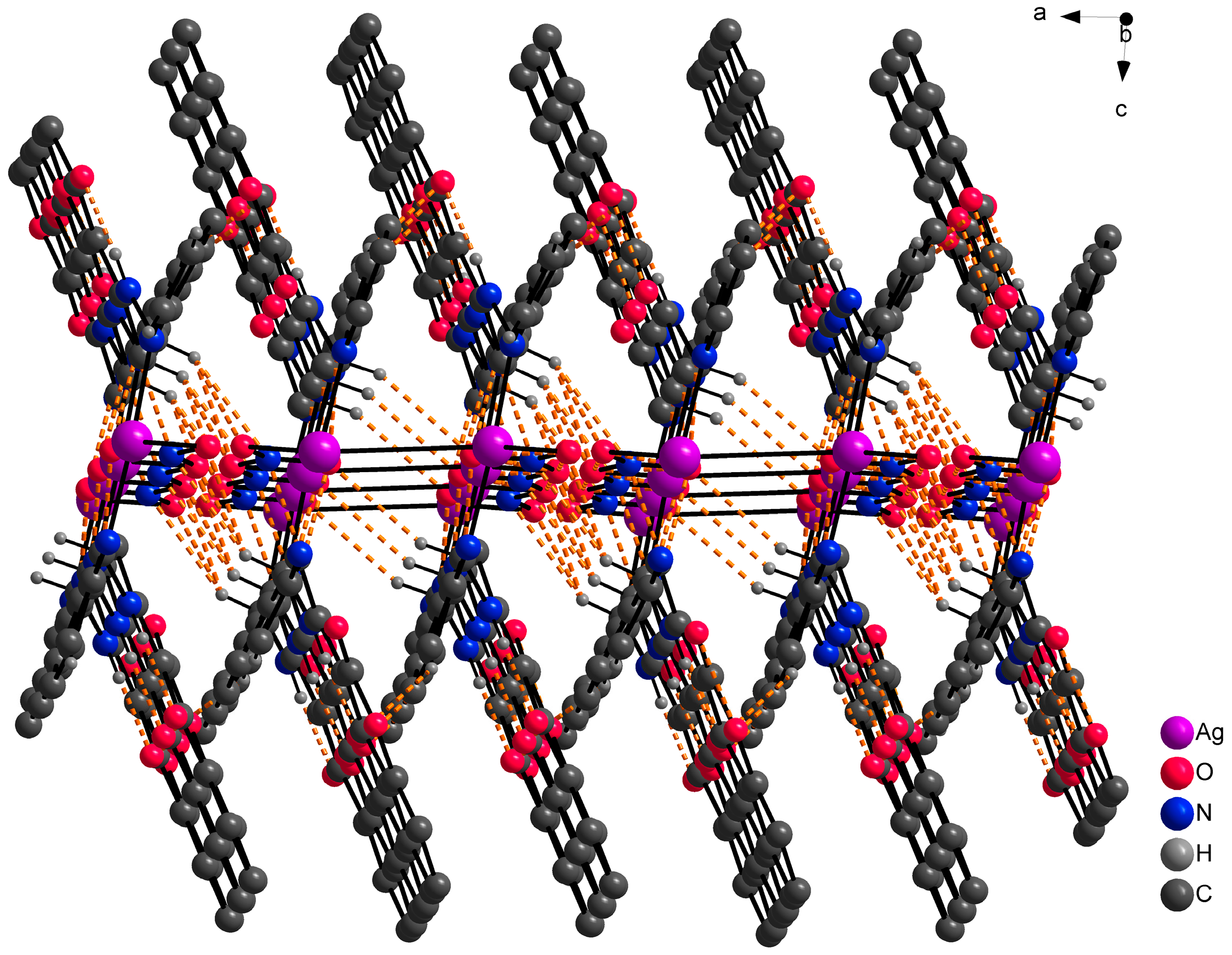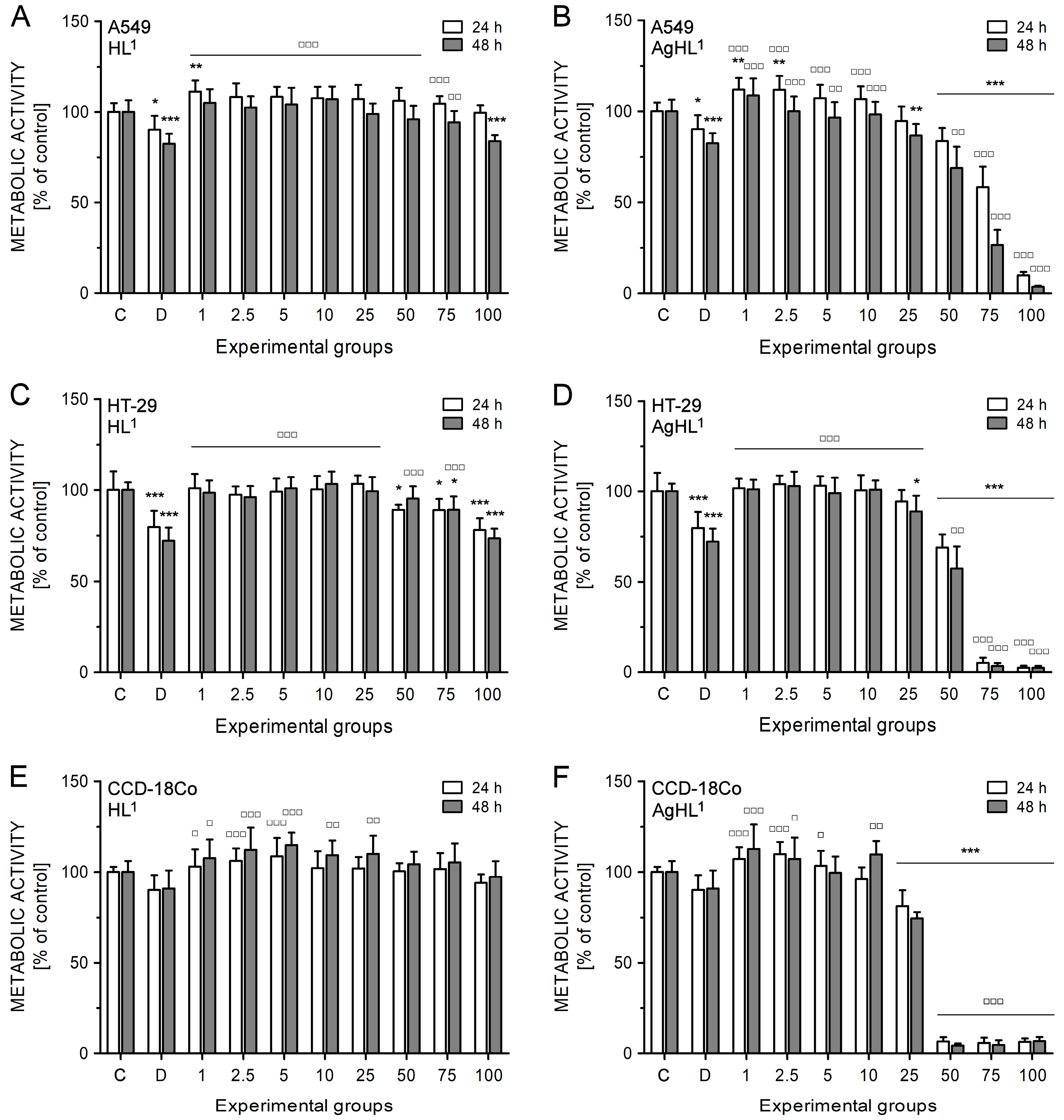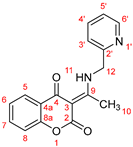The Coumarin-Based Silver(I) Complex Showed Enhanced Antitumor and Antimicrobial Activity than Ligand Itself †
Abstract
1. Introduction
2. Results and Discussion
2.1. Synthesis
2.2. IR and NMR Spectra
2.3. X-Ray Structure Analysis
2.4. In Vitro Antitumor Activity
2.4.1. Effect of HL1 and AgHL1 on Metabolic Activity of A549, HT-29 and CCD-18Co Cell Lines and Determination of IC50 Values
2.4.2. Effect of HL1 and AgHL1 on Proliferation of A549 and HT-29 Carcinoma Cell Lines
2.5. In Vitro Antimicrobial Activity
3. Materials and Methods
3.1. Materials and Chemicals
3.2. Syntheses
3.2.1. Synthesis of HL1
3.2.2. Synthesis of [Ag(HL1)2]NO3 (AgHL1)
3.3. Physical Measurements
3.4. X-Ray Data Collection and Structure Refinement
3.5. In Vitro Antitumor Activity
3.5.1. Cell Lines and Growth Conditions
3.5.2. Reagents and Experimental Design
3.5.3. MTT Assay and IC50 Values Evaluation
3.5.4. Cell Proliferation Assay
3.5.5. Statistical Analysis
3.6. In Vitro Antimicrobial Activity
3.6.1. Test Substances, Microorganisms, and Microbial Suspension
3.6.2. Microdilution Method
4. Conclusions
Supplementary Materials
Author Contributions
Funding
Institutional Review Board Statement
Informed Consent Statement
Data Availability Statement
Conflicts of Interest
References
- Mcquitty, R.J. Metal-Based Drugs. Sci. Prog. 2014, 97, 1–19. [Google Scholar] [CrossRef] [PubMed]
- Peng, K.; Liang, B.-B.; Liu, W.; Mao, Z.-W. What Blocks More Anticancer Platinum Complexes from Experiment to Clinic: Major Problems and Potential Strategies from Drug Design Perspectives. Coord. Chem. Rev. 2021, 449, 214210. [Google Scholar] [CrossRef]
- Biot, C.; Delhaes, L.; N’Diaye, C.M.; Maciejewski, L.A.; Camus, D.; Dive, D.; Brocard, J.S. Synthesis and Antimalarial Activity in Vitro of Potential Metabolites of Ferrochloroquine and Related Compounds. Bioorg. Med. Chem. 1999, 7, 2843–2847. [Google Scholar] [CrossRef] [PubMed]
- Guo, Z.; Sadler, P.J. Metals in Medicine. Angew. Chem. Int. Ed. 1999, 38, 1512–1531. [Google Scholar] [CrossRef]
- Yan, G.-P.; Robinson, L.; Hogg, P. Magnetic Resonance Imaging Contrast Agents: Overview and Perspectives. Radiography 2007, 13, e5–e19. [Google Scholar] [CrossRef]
- Fraise, A.P. Historical Introduction. In Principles and Practice of Disinfection, Preservation & Sterilization; Fraise, A.P., Lambert, P.A., Maillard, J.-Y., Eds.; Blackwell Publishing Ltd.: Hoboken, NJ, USA, 2004; ISBN 1-4051-0199-7. [Google Scholar]
- Moyer, C.A. Treatment of Large Human Burns with 0.5% Silver Nitrate Solution. Arch. Surg. 1965, 90, 812. [Google Scholar] [CrossRef]
- Fox, C.L. Silver Sulfadiazine—A New Topical. Arch. Surg. 1968, 184–188. [Google Scholar] [CrossRef]
- Bessey, P.Q. Wound Care. In Total Burn Care; Herndon, D.N., Ed.; W.B. Saunders: Edinburgh, Scotland, 2007; pp. 127–135. ISBN 978-1-4160-3274-8. [Google Scholar]
- Dai, T.; Huang, Y.-Y.; Sharma, S.K.; Hashmi, J.T.; Kurup, D.B.; Hamblin, M.R. Topical Antimicrobials for Burn Wound Infections. Recent Pat. Anti-Infect. Drug Discov. 2010, 5, 124–151. [Google Scholar] [CrossRef]
- Raju, S.K.; Shridharshini, K.; Praveen, S.; Maruthamuthu, M.; Mohanapriya, K. Silver Complexes as Anticancer Agents: A Perspective Review. Ger. J. Pharm. Biomater. 2022, 1, 06–28. [Google Scholar] [CrossRef]
- Balcıoğlu, S.; Olgun Karataş, M.; Ateş, B.; Alıcı, B.; Özdemir, İ. Therapeutic Potential of Coumarin Bearing Metal Complexes: Where Are We Headed? Bioorg. Med. Chem. Lett. 2020, 30, 126805. [Google Scholar] [CrossRef]
- Matos, M.J.; Santana, L.; Uriarte, E.; Abreu, O.A.; Molina, E.; Yordi, E.G. Coumarins—An Important Class of Phytochemicals. In Phytochemicals-Isolation, Characterisation and Role in Human Health; Rao, A.V., Rao, L.G., Eds.; InTech: Tokyo, Japan, 2015; ISBN 978-953-51-2170-1. [Google Scholar]
- Rettie, A.E. The Pharmocogenomics of Warfarin: Closing in on Personalized Medicine. Mol. Interv. 2006, 6, 223–227. [Google Scholar] [CrossRef]
- Matos, M.; Vazquez-Rodriguez, S.; Santana, L.; Uriarte, E.; Fuentes-Edfuf, C.; Santos, Y.; Muñoz-Crego, A. Synthesis and Structure-Activity Relationships of Novel Amino/Nitro Substituted 3-Arylcoumarins as Antibacterial Agents. Molecules 2013, 18, 1394–1404. [Google Scholar] [CrossRef]
- Kapoor, S. The Anti-Neoplastic Effects of Coumarin: An Emerging Concept. Cytotechnology 2013, 65, 787–788. [Google Scholar] [CrossRef] [PubMed]
- Bansal, Y.; Sethi, P.; Bansal, G. Coumarin: A Potential Nucleus for Anti-Inflammatory Molecules. Med. Chem. Res. 2013, 22, 3049–3060. [Google Scholar] [CrossRef]
- Xu, Z.; Chen, Q.; Zhang, Y.; Liang, C. Coumarin-Based Derivatives with Potential Anti-HIV Activity. Fitoterapia 2021, 150, 104863. [Google Scholar] [CrossRef]
- Thati, B.; Noble, A.; Creaven, B.S.; Walsh, M.; McCann, M.; Devereux, M.; Kavanagh, K.; Egan, D.A. Role of Cell Cycle Events and Apoptosis in Mediating the Anti-Cancer Activity of a Silver(I) Complex of 4-Hydroxy-3-Nitro-Coumarin-Bis(Phenanthroline) in Human Malignant Cancer Cells. Eur. J. Pharmacol. 2009, 602, 203–214. [Google Scholar] [CrossRef] [PubMed]
- Mujahid, M.; Kia, A.F.-A.; Duff, B.; Egan, D.A.; Devereux, M.; McClean, S.; Walsh, M.; Trendafilova, N.; Georgieva, I.; Creaven, B.S. Spectroscopic Studies, DFT Calculations, and Cytotoxic Activity of Novel Silver(I) Complexes of Hydroxy Ortho-Substituted-Nitro-2H-Chromen-2-One Ligands and a Phenanthroline Adduct. J. Inorg. Biochem. 2015, 153, 103–113. [Google Scholar] [CrossRef] [PubMed]
- Brawley, J.; Etter, E.; Heredia, D.; Intasiri, A.; Nennecker, K.; Smith, J.; Welcome, B.M.; Brizendine, R.K.; Gould, T.W.; Bell, T.W.; et al. Synthesis and Evaluation of 4-Hydroxycoumarin Imines as Inhibitors of Class II Myosins. J. Med. Chem. 2020, 63, 11131–11148. [Google Scholar] [CrossRef]
- OECD. Onkologický Profil Krajiny: Slovenská Republika 2023. In EU Country Cancer Profiles; OECD Publishing: Paris, France, 2023; ISBN 9789264710344. [Google Scholar]
- Fromm, K.M. Silver Coordination Compounds with Antimicrobial Properties. Appl. Organomet. Chem. 2013, 27, 683–687. [Google Scholar] [CrossRef]
- Sukdolak, S.; Solujić, S.; Manojlović, N.; Vuković, N.; Krstić, L.J. Hantzsch Reaction of 3-(2-Bromoacetyl)-4-Hydroxy-Chromen-2-One. Synthesis of 3-(Thiazol-4-Yl)-4-Hydroxy Coumarines. J. Heterocycl. Chem. 2004, 41, 593–596. [Google Scholar] [CrossRef]
- Ilić, D.R.; Jevtić, V.V.; Radić, G.P.; Arsikin, K.; Ristić, B.; Harhaji-Trajković, L.; Vuković, N.; Sukdolak, S.; Klisurić, O.; Trajković, V.; et al. Synthesis, Characterization and Cytotoxicity of a New Palladium(II) Complex with a Coumarine-Derived Ligand. Eur. J. Med. Chem. 2014, 74, 502–508. [Google Scholar] [CrossRef] [PubMed]
- Kurjan, J.; Jendželovská, Z.; Smolková, R.; Volarevic, V.; Smolko, L.; Jendželovský, R.; Potočňák, I. Manuscript in Preparation; Pavol Jozef Šafárik University: Košice, Slovakia, 2025. [Google Scholar]
- Butera, V.; D’Anna, L.; Rubino, S.; Bonsignore, R.; Spinello, A.; Terenzi, A.; Barone, G. How the Metal Ion Affects the 1H NMR Chemical Shift Values of Schiff Base Metal Complexes: Rationalization by DFT Calculations. J. Phys. Chem. A 2023, 127, 9283–9290. [Google Scholar] [CrossRef]
- El-Naggar, M.A.; Sharaf, M.M.; Albering, J.H.; Abu-Youssef, M.A.M.; Kassem, T.S.; Soliman, S.M.; Badr, A.M.A. One Pot Synthesis of Two Potent Ag(I) Complexes with Quinoxaline Ligand, X-Ray Structure, Hirshfeld Analysis, Antimicrobial, and Antitumor Investigations. Sci. Rep. 2022, 12, 20881. [Google Scholar] [CrossRef] [PubMed]
- Sakharov, S.G.; Kovalev, V.V.; Gorbunova, Y.E.; Tokmakov, G.P.; Skabitskii, I.V.; Kokunov, Y.V. Structures of Silver Nitrate Complexes with Quinolines According to NMR Data. Russ. J. Coord. Chem. 2017, 43, 75–81. [Google Scholar] [CrossRef]
- Dalvit, C.; Veronesi, M.; Vulpetti, A. 1H and 19F NMR Chemical Shifts for Hydrogen Bond Strength Determination: Correlations between Experimental and Computed Values. J. Magn. Reson. 2022, 12–13, 100070. [Google Scholar] [CrossRef]
- Gilli, G.; Bellucci, F.; Ferretti, V.; Bertolasi, V. Evidence for Resonance-Assisted Hydrogen Bonding from Crystal-Structure Correlations on the Enol Form of the Beta-Diketone Fragment. J. Am. Chem. Soc. 1989, 111, 1023–1028. [Google Scholar] [CrossRef]
- Avdović, E.H.; Stojković, D.L.J.; Jevtić, V.V.; Kosić, M.; Ristić, B.; Harhaji-Trajković, L.; Vukić, M.; Vuković, N.; Marković, Z.S.; Potočňák, I.; et al. Synthesis, Characterization and Cytotoxicity of a New Palladium(II) Complex with a Coumarin-Derived Ligand 3-(1-(3-Hydroxypropylamino)Ethylidene)Chroman-2,4-Dione. Crystal Structure of the 3-(1-(3-Hydroxypropylamino)Ethylidene)-Chroman-2,4-Dione. Inorg. Chim. Acta 2017, 466, 188–196. [Google Scholar] [CrossRef]
- Usman, M.; Zaki, M.; Khan, R.A.; Alsalme, A.; Ahmad, M.; Tabassum, S. Coumarin Centered Copper(II) Complex with Appended-Imidazole as Cancer Chemotherapeutic Agents against Lung Cancer: Molecular Insight via DFT-Based Vibrational Analysis. RSC Adv. 2017, 7, 36056–36071. [Google Scholar] [CrossRef]
- Bruno, I.J.; Cole, J.C.; Edgington, P.R.; Kessler, M.; Macrae, C.F.; McCabe, P.; Pearson, J.; Taylor, R. New Software for Searching the Cambridge Structural Database and Visualizing Crystal Structures. Acta Crystallogr. Sect. B Struct. Sci. 2002, 58, 389–397. [Google Scholar] [CrossRef]
- Wang, P.-N.; Yeh, C.-W.; Tsou, C.-H.; Ho, Y.-W.; Lin, S.-C.; Suen, M.-C. Structural Diversity in the Self-Assembly of Ag(i) Complexes Containing 2,6-Dimethyl-3,5-Dicyano-4-(3-Pyridyl)-1,4-Dihydropyridine. New J. Chem. 2014, 38, 1079. [Google Scholar] [CrossRef]
- Ratte, H.T. Bioaccumulation and Toxicity of Silver Compounds: A Review. Environ. Toxicol. Chem. 1999, 18, 89–108. [Google Scholar] [CrossRef]
- Żyro, D.; Radko, L.; Śliwińska, A.; Chęcińska, L.; Kusz, J.; Korona-Głowniak, I.; Przekora, A.; Wójcik, M.; Posyniak, A.; Ochocki, J. Multifunctional Silver(I) Complexes with Metronidazole Drug Reveal Antimicrobial Properties and Antitumor Activity against Human Hepatoma and Colorectal Adenocarcinoma Cells. Cancers 2022, 14, 900. [Google Scholar] [CrossRef]
- Budzisz, E.; Keppler, B.K.; Giester, G.; Wozniczka, M.; Kufelnicki, A.; Nawrot, B. Synthesis, Crystal Structure and Biological Characterization of a Novel Palladium( II ) Complex with a Coumarin-Derived Ligand. Eur. J. Inorg. Chem. 2004, 2004, 4412–4419. [Google Scholar] [CrossRef]
- Buľková, V.; Vargová, J.; Babinčák, M.; Jendželovský, R.; Zdráhal, Z.; Roudnický, P.; Košuth, J.; Fedoročko, P. New Findings on the Action of Hypericin in Hypoxic Cancer Cells with a Focus on the Modulation of Side Population Cells. Biomed. Pharmacother. 2023, 163, 114829. [Google Scholar] [CrossRef]
- Leong, K.H.; Looi, C.Y.; Loong, X.-M.; Cheah, F.K.; Supratman, U.; Litaudon, M.; Mustafa, M.R.; Awang, K. Cycloart-24-Ene-26-Ol-3-One, a New Cycloartane Isolated from Leaves of Aglaia Exima Triggers Tumour Necrosis Factor-Receptor 1-Mediated Caspase-Dependent Apoptosis in Colon Cancer Cell Line. PLoS ONE 2016, 11, e0152652. [Google Scholar] [CrossRef]
- Creaven, B.S.; Egan, D.A.; Kavanagh, K.; McCann, M.; Noble, A.; Thati, B.; Walsh, M. Synthesis, Characterization and Antimicrobial Activity of a Series of Substituted Coumarin-3-Carboxylatosilver(I) Complexes. Inorg. Chim. Acta 2006, 359, 3976–3984. [Google Scholar] [CrossRef]
- Mujahid, M.; Trendafilova, N.; Arfa-Kia, A.F.; Rosair, G.; Kavanagh, K.; Devereux, M.; Walsh, M.; McClean, S.; Creaven, B.S.; Georgieva, I. Novel Silver(I) Complexes of Coumarin Oxyacetate Ligands and Their Phenanthroline Adducts: Biological Activity, Structural and Spectroscopic Characterisation. J. Inorg. Biochem. 2016, 163, 53–67. [Google Scholar] [CrossRef] [PubMed]
- Karataş, M.O.; Olgundeniz, B.; Günal, S.; Özdemir, İ.; Alıcı, B.; Çetinkaya, E. Synthesis, Characterization and Antimicrobial Activities of Novel Silver(I) Complexes with Coumarin Substituted N-Heterocyclic Carbene Ligands. Bioorg. Med. Chem. 2016, 24, 643–650. [Google Scholar] [CrossRef]
- Achar, G.; Ramya, V.C.; Upendranath, K.; Budagumpi, S. Coumarin-tethered (Benz)Imidazolium Salts and Their Silver(I) N-heterocyclic Carbene Complexes: Synthesis, Characterization, Crystal Structure and Antibacterial Studies. Appl. Organomet. Chem. 2017, 31, e3770. [Google Scholar] [CrossRef]
- Achar, G.; Shahini, C.R.; Patil, S.A.; Budagumpi, S. Synthesis, Structural Characterization, Crystal Structures and Antibacterial Potentials of Coumarin–Tethered N–Heterocyclic Carbene Silver(I) Complexes. J. Organomet. Chem. 2017, 833, 28–42. [Google Scholar] [CrossRef]
- Achar, G.; Uppendranath, K.; Ramya, V.C.; Biffis, A.; Keri, R.S.; Budagumpi, S. Synthesis, Characterization, Crystal Structure and Biological Studies of Silver(I) Complexes Derived from Coumarin-Tethered N-Heterocyclic Carbene Ligands. Polyhedron 2017, 123, 470–479. [Google Scholar] [CrossRef]
- Achar, G.; Agarwal, P.; Brinda, K.N.; Małecki, J.G.; Keri, R.S.; Budagumpi, S. Ether and Coumarin–Functionalized (Benz)Imidazolium Salts and Their Silver(I)–N–Heterocyclic Carbene Complexes: Synthesis, Characterization, Crystal Structures and Antimicrobial Studies. J. Organomet. Chem. 2018, 854, 64–75. [Google Scholar] [CrossRef]
- Ranjan Sahoo, C.; Sahoo, J.; Mahapatra, M.; Lenka, D.; Kumar Sahu, P.; Dehury, B.; Nath Padhy, R.; Kumar Paidesetty, S. Coumarin Derivatives as Promising Antibacterial Agent(s). Arab. J. Chem. 2021, 14, 102922. [Google Scholar] [CrossRef]
- Jaiswal, S.; Bhattacharya, K.; Sullivan, M.; Walsh, M.; Creaven, B.S.; Laffir, F.; Duffy, B.; McHale, P. Non-Cytotoxic Antibacterial Silver–Coumarin Complex Doped Sol–Gel Coatings. Colloids Surf. B 2013, 102, 412–419. [Google Scholar] [CrossRef]
- Li, W.-R.; Sun, T.-L.; Zhou, S.-L.; Ma, Y.-K.; Shi, Q.-S.; Xie, X.-B.; Huang, X.-M. A Comparative Analysis of Antibacterial Activity, Dynamics, and Effects of Silver Ions and Silver Nanoparticles against Four Bacterial Strains. Int. Biodeterior. Biodegrad. 2017, 123, 304–310. [Google Scholar] [CrossRef]
- Kvitek, L.; Panacek, A.; Prucek, R.; Soukupova, J.; Vanickova, M.; Kolar, M.; Zboril, R. Antibacterial Activity and Toxicity of Silver – Nanosilver versus Ionic Silver. J. Phys. Conf. Ser. 2011, 304, 012029. [Google Scholar] [CrossRef]
- Parvekar, P.; Palaskar, J.; Metgud, S.; Maria, R.; Dutta, S. The Minimum Inhibitory Concentration (MIC) and Minimum Bactericidal Concentration (MBC) of Silver Nanoparticles against Staphylococcus aureus. Biomater. Investig. Dent. 2020, 7, 105–109. [Google Scholar] [CrossRef]
- Claudel, M.; Schwarte, J.V.; Fromm, K.M. New Antimicrobial Strategies Based on Metal Complexes. Chemistry 2020, 2, 849–899. [Google Scholar] [CrossRef]
- Ishida, T. Antibacterial Mechanism of Ag+ Ions for Bacteriolyses of Bacterial Cell Walls via Peptidoglycan Autolysins, and DNA Damages. MOJ Toxicol. 2018, 4, 345–350. [Google Scholar] [CrossRef]
- Feng, Q.L.; Wu, J.; Chen, G.Q.; Cui, F.Z.; Kim, T.N.; Kim, J.O. A Mechanistic Study of the Antibacterial Effect of Silver Ions onEscherichia Coli andStaphylococcus Aureus. J. Biomed. Mater. Res. 2000, 52, 662–668. [Google Scholar] [CrossRef]
- Randall, C.P.; Oyama, L.B.; Bostock, J.M.; Chopra, I.; O’Neill, A.J. The Silver Cation (Ag+): Antistaphylococcal Activity, Mode of Action and Resistance Studies. J. Antimicrob. Chemother. 2013, 68, 131–138. [Google Scholar] [CrossRef]
- Ge, C.; Huang, M.; Huang, D.; Dang, F.; Huang, Y.; Ahmad, H.A.; Zhu, C.; Chen, N.; Wu, S.; Zhou, D. Effect of Metal Cations on Antimicrobial Activity and Compartmentalization of Silver in Shewanella Oneidensis MR-1 upon Exposure to Silver Ions. Sci. Total Environ. 2022, 838, 156401. [Google Scholar] [CrossRef] [PubMed]
- Mohamed, D.S.; Abd El-Baky, R.M.; Sandle, T.; Mandour, S.A.; Ahmed, E.F. Antimicrobial Activity of Silver-Treated Bacteria against Other Multi-Drug Resistant Pathogens in Their Environment. Antibiotics 2020, 9, 181. [Google Scholar] [CrossRef]
- CrysAlisPRO, Version 1.0.43, Oxford Diffraction/Agilent Technologies UK Ltd.: Yarnton, UK, 2020.
- Sheldrick, G.M. SHELXT–Integrated Space-Group and Crystal-Structure Determination. Acta Crystallogr. Sect. A Found. Adv. 2015, 71, 3–8. [Google Scholar] [CrossRef] [PubMed]
- Sheldrick, G.M. Crystal Structure Refinement with SHELXL. Acta Crystallogr. Sect. C Struct. Chem. 2015, 71, 3–8. [Google Scholar] [CrossRef]
- Farrugia, L.J. WinGX and ORTEP for Windows: An Update. J. Appl. Crystallogr. 2012, 45, 849–854. [Google Scholar] [CrossRef]
- Spek, A.L. Structure Validation in Chemical Crystallography. Acta Crystallogr. Sect. D Biol. Crystallogr. 2009, 65, 148–155. [Google Scholar] [CrossRef]
- Brandenburg, K. DIAMOND, Version 3.2k ed; Crystal Impact GbR: Bonn, Germany, 2014. [Google Scholar]
- Andrews, J.M. Determination of Minimum Inhibitory Concentrations. J. Antimicrob. Chemother. 2001, 48 (Suppl. 1), 5–16. [Google Scholar] [CrossRef] [PubMed]
- Sarker, S.D.; Nahar, L.; Kumarasamy, Y. Microtitre Plate-Based Antibacterial Assay Incorporating Resazurin as an Indicator of Cell Growth, and Its Application in the in Vitro Antibacterial Screening of Phytochemicals. Methods 2007, 42, 321–324. [Google Scholar] [CrossRef]
- Radić, G.P.; Glođović, V.V.; Radojević, I.D.; Stefanović, O.D.; Čomić, L.R.; Ratković, Z.R.; Valkonen, A.; Rissanen, K.; Trifunović, S.R. Synthesis, Characterization and Antimicrobial Activity of Palladium(II) Complexes with Some Alkyl Derivates of Thiosalicylic Acids: Crystal Structure of the Bis(S-Benzyl-Thiosalicylate)–Palladium(II) Complex, [Pd(S-Bz-Thiosal)2]. Polyhedron 2012, 31, 69–76. [Google Scholar] [CrossRef]








 | ||||
|---|---|---|---|---|
| HL1 | AgHL1 | |||
| Atom | δH, mult. (J, Hz) | δC | δH, mult. (J, Hz) | δC |
| 2 | - | 162.0 | - | 162.0 |
| 3 | - | 96.4 | - | 96.4 |
| 4 | - | 179.5 | - | 179.5 |
| 4a | - | 120.3 | - | 120.3 |
| 5 | 7.96 (dd, 7.8, 1.7) | 125.7 | 7.96 (dd, 7.8, 1.5) | 125.7 |
| 6 | 7.29 (ddd, 8.1, 7.3, 1.0) | 123.7 | 7.29 (ddd, 8.1, 7.2, 1.1) | 123.6 |
| 7 | 7.63 (ddd, 8.2, 7.2, 1.7) | 134.0 | 7.63 (ddd, 8.2, 7.2, 1.7) | 134.0 |
| 8 | 7.26 (dd, 8.2, 1.1) | 116.2 | 7.26 (dd, 8.2, 1.0) | 116.2 |
| 8a | - | 153.1 | - | 153.1 |
| 9 | - | 176.2 | - | 176.2 |
| 10 | 2.75 (s) | 19.0 | 2.75 (s) | 19.0 |
| 11 | 14.14 (s) | - | 14.14 (s) | - |
| 12 | 5.04 (d, 5.1) | 48.7 | 5.04 (d, 5.2) | 48.8 |
| 2′ | - | 154.6 | - | 154.6 |
| 3’ | 7.47 (d, 7.9) | 122.2 | 7.48 (dt, 7.8, 1.0) | 122.2 |
| 4’ | 7.87 (td, 7.7, 1.8) | 137.3 | 7.87 (td, 7.8, 1.8) | 137.4 |
| 5’ | 7.39 (ddd, 7.5, 4.8, 1.1) | 123.1 | 7.40 (ddd, 7.6, 4.8, 1.0) | 123.1 |
| 6’ | 8.64 (ddd, 4.8, 1.8, 0.9) | 149.3 | 8.64 (ddd, 4.9, 1.8, 1.0) | 149.4 |
| Bonds | Angles | ||
|---|---|---|---|
| O4-C4 | 1.2539(16) | O4-C4-C3 | 124.01(11) |
| C4-C3 | 1.4392(17) | C4-C3-C11 | 119.94(11) |
| C3-C11 | 1.4413(17) | C3-C11-N13 | 118.09(11) |
| C11-N13 | 1.3168(16) | ||
| Bonds | Angles | ||
|---|---|---|---|
| Ag1-N20 | 2.170(4) | N20-Ag1-N20’ | 176.69(17) |
| O4-C4 | 1.250(7) | O4-C4-C3 | 124.4(5) |
| C4-C3 | 1.450(8) | C4-C3-C11 | 120.2(5) |
| C3-C11 | 1.437(8) | C3-C11-N13 | 117.6(5) |
| C11-N13 | 1.319(7) | O4’-C4’-C3’ | 124.6(5) |
| Ag1-N20’ | 2.170(4) | C4’-C3’-C11’ | 120.2(5) |
| O4’-C4’ | 1.254(7) | C3’-C11’-N13’ | 119.2(5) |
| C4’-C3’ | 1.450(7) | ||
| C3’-C11’ | 1.453(8) | ||
| C11’-N13’ | 1.315(7) | ||
| Ag1-O31 | 2.806(4) | ||
| D-H⋯A | d(D-H) | d(H⋯A) | d(D⋯A) | <(DHA) |
|---|---|---|---|---|
| N13-H13⋯O4 | 0.88 | 1.79 | 2.548(6) | 142.4 |
| N13’-H13’⋯O4’ | 0.88 | 1.78 | 2.545(6) | 143.8 |
| C18-H18⋯O4’ i | 0.95 | 2.40 | 3.190(7) | 140.0 |
| C18’-H18’⋯O4 ii | 0.95 | 2.47 | 3.220(7) | 135.6 |
| C19’-H19’⋯O32 i | 0.95 | 2.51 | 3.371(8) | 151.3 |
| C14’-H14D⋯O32 iii | 0.99 | 2.56 | 3.461(7) | 150.7 |
| C19-H19⋯O32 i | 0.95 | 2.48 | 3.350(7) | 152.2 |
| C19-H19⋯N30 i | 0.95 | 2.57 | 3.303(7) | 134.6 |
| C14-H14A⋯O31 | 0.99 | 2.49 | 3.046(7) | 115.1 |
| C14-H14A⋯O33 | 0.99 | 2.53 | 3.325(8) | 137.5 |
| A549 | HT-29 | CCD-18Co | ||||
|---|---|---|---|---|---|---|
| 24 h | 48 h | 24 h | 48 h | 24 h | 48 h | |
| HL1 | >100 | >100 | >100 | >100 | >100 | >100 |
| AgHL1 | 79 ± 5 | 60 ± 8 | 56 ± 2 | 53 ± 2 | 32 ± 1 | 29 ± 1 |
| AgNO3 | 61 ± 3 | 62 ± 2 | 35 ± 2 | 36 ± 1 | - | - |
| Species/Substances | HL1 | AgHL1 | AgNO3 | Doxycycline/ Fluconazole | ||||
|---|---|---|---|---|---|---|---|---|
| Bacillus cereus | >1000 | >1000 | 62.5 | 125 | 15.62 | 31.25 | 0.98 | 7.81 |
| Bacillus subtilis ATCC 6633 | >1000 | >1000 | 7.81 | 15.78 | 7.81 | 15.62 | 1.953 | 31.25 |
| Staphylococcus aureus ATCC 25923 | >1000 | >1000 | 62.5 | 125 | 15.62 | 31.25 | 0.224 | 3.75 |
| Staphylococcus aureus | >1000 | >1000 | 125 | 250 | 15.62 | 31.25 | 0.45 | 7.81 |
| Proteus mirabilis ATCC 12453 | >1000 | >1000 | 31.25 | 62.5 | 15.62 | 31.25 | 7.81 | 15.63 |
| Pseudomonas aeruginosa ATCC 27853 | >1000 | >1000 | 31.25 | 62.5 | 31.25 | 62.50 | 62.5 | 125 |
| Pseudomonas aeruginosa | 1000 | >1000 | 15.78 | 31.25 | 15.62 | 15.62 | 250 | 1000 |
| Escherichia coli ATCC 25922 | 1000 | >1000 | 62.5 | 125 | 15.62 | 62.50 | 15.63 | 31.25 |
| Escherichia coli | >1000 | >1000 | 62.5 | 125 | 15.62 | 31.25 | 15.63 | 62.5 |
| Salmonella enterica | >1000 | >1000 | 62.5 | 125 | 15.62 | 31.25 | 15.63 | 31.25 |
| Candida albicans ATCC 10231 | 1000 | >1000 | 250 | 500 | 62.50 | 125 | 7.81 | 31.25 |
| Aspergillus fumigatus | 1000 | >1000 | 31.25 | 62.5 | 15.62 | 15.62 | 1000 | 1000 |
| Trichoderma viridae | 1000 | 1000 | 62.5 | 125 | 31.25 | 31.25 | 500 | 1000 |
| Mucor mucedo | 250 | 250 | 15.78 | 31.25 | 31.25 | 31.25 | 250 | 250 |
| Aspergillus niger ATCC 16404 | 1000 | 1000 | 31.25 | 62.5 | 31.25 | 31.25 | 1000 | 1000 |
Disclaimer/Publisher’s Note: The statements, opinions and data contained in all publications are solely those of the individual author(s) and contributor(s) and not of MDPI and/or the editor(s). MDPI and/or the editor(s) disclaim responsibility for any injury to people or property resulting from any ideas, methods, instructions or products referred to in the content. |
© 2025 by the authors. Licensee MDPI, Basel, Switzerland. This article is an open access article distributed under the terms and conditions of the Creative Commons Attribution (CC BY) license (https://creativecommons.org/licenses/by/4.0/).
Share and Cite
Kurjan, J.; Jendželovská, Z.; Dečmanová, V.; Vilková, M.; Ćirković, K.; Radojević, I.; Litecká, M.; Jendželovský, R.; Potočňák, I. The Coumarin-Based Silver(I) Complex Showed Enhanced Antitumor and Antimicrobial Activity than Ligand Itself. Inorganics 2025, 13, 164. https://doi.org/10.3390/inorganics13050164
Kurjan J, Jendželovská Z, Dečmanová V, Vilková M, Ćirković K, Radojević I, Litecká M, Jendželovský R, Potočňák I. The Coumarin-Based Silver(I) Complex Showed Enhanced Antitumor and Antimicrobial Activity than Ligand Itself. Inorganics. 2025; 13(5):164. https://doi.org/10.3390/inorganics13050164
Chicago/Turabian StyleKurjan, Jakub, Zuzana Jendželovská, Viktória Dečmanová, Mária Vilková, Katarina Ćirković, Ivana Radojević, Miroslava Litecká, Rastislav Jendželovský, and Ivan Potočňák. 2025. "The Coumarin-Based Silver(I) Complex Showed Enhanced Antitumor and Antimicrobial Activity than Ligand Itself" Inorganics 13, no. 5: 164. https://doi.org/10.3390/inorganics13050164
APA StyleKurjan, J., Jendželovská, Z., Dečmanová, V., Vilková, M., Ćirković, K., Radojević, I., Litecká, M., Jendželovský, R., & Potočňák, I. (2025). The Coumarin-Based Silver(I) Complex Showed Enhanced Antitumor and Antimicrobial Activity than Ligand Itself. Inorganics, 13(5), 164. https://doi.org/10.3390/inorganics13050164









